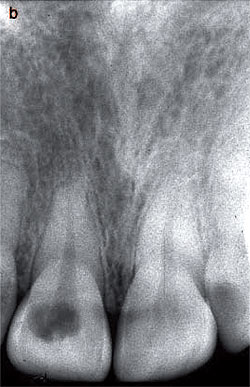 Internal resorption is a condition where the slow or fast resorption of the dentin of the pulp, and the internal walls of the root canals occurs. It is named as Pink tooth of Mummery after the anatomist – James Howard Mummery.
Internal resorption is a condition where the slow or fast resorption of the dentin of the pulp, and the internal walls of the root canals occurs. It is named as Pink tooth of Mummery after the anatomist – James Howard Mummery.
Cause and symptoms
The cause of this condition is not clearly known, except of few patients complaining about trauma to the teeth. Also, persistant chronic pulpitis may sometimes cause the internal resorption. This is another asymptomatic condition, and a type of Chronic irreversible pulpitis (other types include Pulp Polyp).
The crown of the tooth clearly shows a reddish spot, called as Pink Spot which represents the granulation tissue, showing the resorbed area of the tooth. The resorption can be confined to just the crown or the root, or sometimes both. The duration can also vary, with slow progression for 1-2 years or rapid progression within a few months. There is pain seen if there is severe resorption, leading to perforation of the crown.
Diagnosis
Radiographic changes –
- Radiolucent enlargement of pulp canal
- Original root canal outline is distorted
- Changes in the bone not usually seen, but visible only when the root perforation occurs
Pulp vitality tests are usually positive, because although the coronal pulp is not responsive, the apical pulp is still vital.
Treatment
The internal resorption can be stopped by Pulp extirpation procedure. In some, the condition still progresses to finally perforate the root, where calcium hydroxide paste is sealed to repair that area and form a calcific barrier. After this is done, plasticized gutta-percha is used for obturating the open canals.

nice blog here. very informative. 🙂
nice information but you didnt explain exact causes
looks scary for me..
What can be the cause of this problem? And what are the precautions to avoid such problems.
Ouch – time for a root canal!
What can the cause pink tooth of Mummery? Can you explain in detail?
This looks very terrible for me.
Thank you doctor…
My daughter just had a pink tooth removed. She is only 8 years old. What do you think the cause be and how can we avoid it in the future? She brushes everyday and never had trauma to her teeth. Please help
We ran into an internal resorbtion lower molar case of our own that we treated with the new laser PIPS technique. This case would have been a real bear to treat but with the Er:YAG and PIPS it was a breeze! Check it out at http://www.capedental.com/blog/2010/10/01/5/
Had a trama accident, lost 7, 8, 9, 10. Had root canal therapy, now all tooth are suffering from internal resorption. Do not treat trama with root canal therapy, end up paying twice as much and suffer twice as long.
I used Fosamax for 5 years,when I read about jaw bones deterioating. I now have internal resorption
in an upper molar. Optins seem to been root canal, inplant or crown. At 77, I’m willing to wait and see.
actually there is no exact etiology for this… this could be caused by various factos… either by pulp infection or by inflamation of pulp tissues or by some metabolic disorder…
there is no cure for it tooth totally decays and root canal is not possible.
i have lost three teeth.
there is etiology for this…hyperparathyroidism. I have internal root resorption of the front two teeth. i had an autoimmune reaction.
Porphyria. An error in hemoglobin metabolism. Thought to be rare, but the more complex the process, the more opportunity for error (and there are several steps in the process). Excess pink, red, purple pigments (porphyrins) can deposit in just about any body tissue. Sometimes visible in normal light; sometimes only under UV light. Porphyria also results in a lack of oxygenated red blood cells – so there’s also a lack of oxygen supply to tissues (can result in necrosis or poor wound healing). Very hard to diagnose, as it tends to be sporadic, day to day.